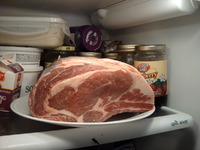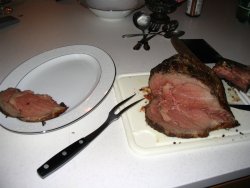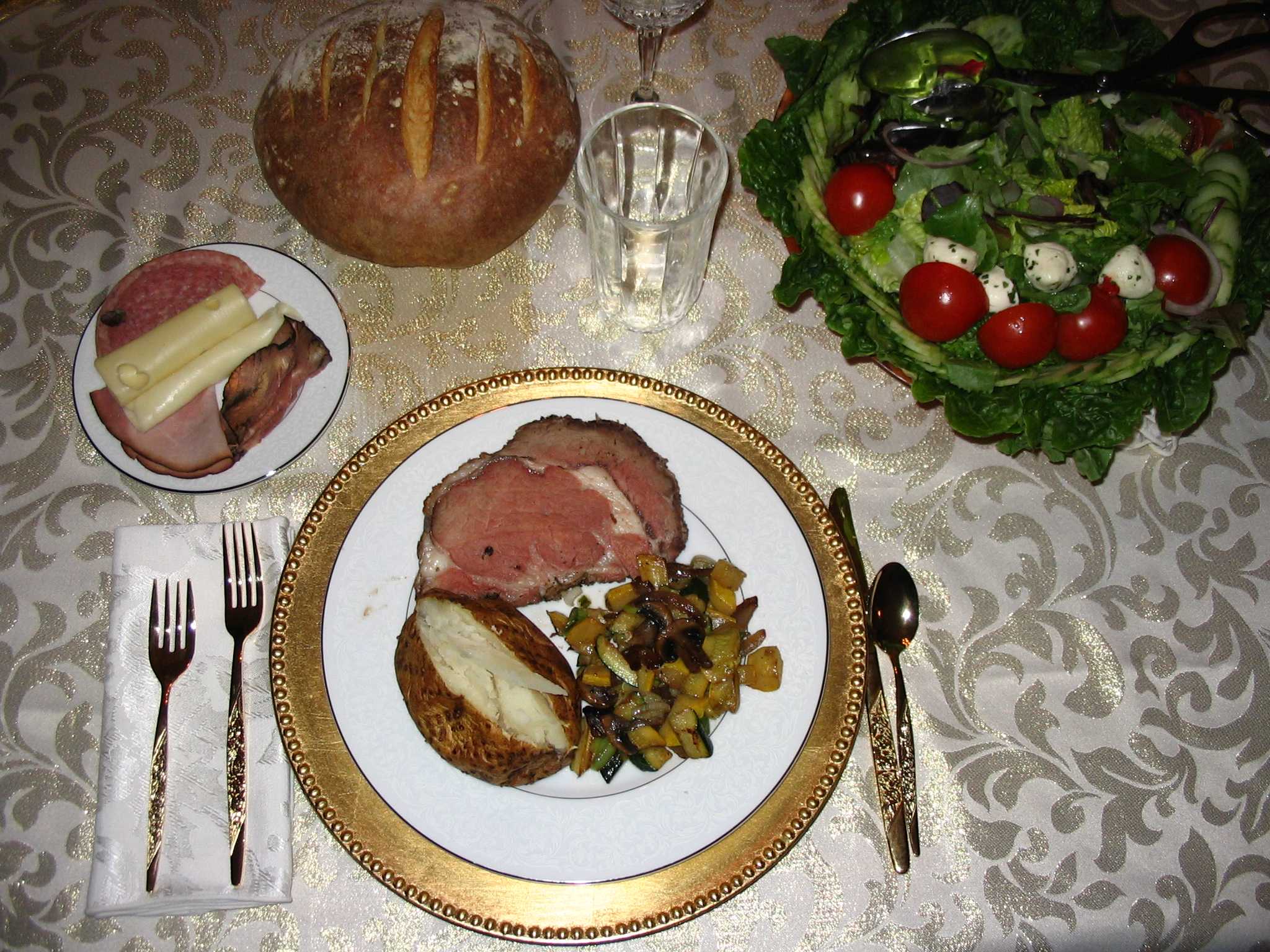Here is how I do prime rib plus some other suggestions and thoughts just to confuse the issue. Some of these ideas come from concrete sources such as Alton Brown’s Good Eats episodes (in particular, “Celebrity Roast”), but most of it is my own experience born of years of trial and error.

What is prime rib? Prime refers to the quality of the beef and is a rating given by the United States Department of Agriculture. Successively lower cuts are choice and select. Rib is the provenance of the roast. What you get in a restaurant serving prime rib is always going to be the roast out of which a ribeye steak is cut. Formally speaking, prime rib can also apply to the area from which the New York is cut, but this is never what we think of as prime rib.
The roast at the right is from 2012; it didn't look too promising, but it did turn out well. The illustrations below are a roast from 2008.
| — | beef prime rib, about ¾ lb meat per person uncooked weight |
| 4-6 tbsp | olive oil |
| 5 cloves | fresh garlic, minced |
| 2 tbsp | herb seasoning such as “Italian Seasoning,” rosemary or sage |
| 1 oz | black pepper, fresh-ground |
| ½ cup | kosher salt |
Preliminary remarks

Buy the biggest roast you can find that will fit your needs; never buy two. Ensure that the butcher/store leaves the rib bones on it and a crown of fat. One of the grocery store butchers I frequent recuts a little blanket of fat and gives it to me in a package for free. I set it on top while roasting.
Store roast in a ventilated container in the refrigerator for two or three days to drop its moisture content and concentrate the flavors. This also allows for natural biological processes to break down the meat which probably wasn’t hung as long as it could have been.
For roasting, I use a thermometer with probe that can sit outside the oven and I don’t even have to open the oven repeatedly and repoke the roast thereby making more holes out of which nice juices leak as I would have to with an instant-read thermometer.
Procedure
1. Get the roast out of the refrigerator a couple of hours before roasting. Trim any areas that have dried out in the refrigerator. If not already done by butcher, cut down along the bones (between rib bones and flesh), but not all the way through. Pack resulting “pocket” with garlic and herbs of your choosing.
Rosemary or sage are really good, but don’t go overboard: it’s easy to get too much of a good thing. One fat twig of rosemary running the length of the roast will probably suffice.
2. After seasoning, drizzle olive oil over it and then pile coarse, Kosher salt on the roast in the roasting pan. Alternatively, you can encrust the roast with crushed peppercorns (this doesn’t make it hot and inedible if you use this technique from the folks at America’s Test Kitchen).
Alton Brown suggests putting it into a clay roaster to even out the oven temperature. I’ve tried this, but don’t seem to need the help in my convection oven.
3. Roast at low temperature, 200°-230°, until internal temperature reaches 118°. This will take a very long time as compared to what you are used to. Remove roast and cover with foil until it stops coasting up in temperature.
I think my last 6-pound roast spent about 3 hours at 230°. It is better to error on the side of starting too early or you will be tempted to hurry things (by turning the temperature up). Your roast can sit, tented, for an hour. Then put it a few seconds (not minutes) in the microwave to boost its internal temperature (for eating pleasure and not for pushing it into medium from rare) before getting the final “burn” described below.
Cooking time (not including sear)
If you don’t have a thermometer, leave the roast the time shown. I strongly recommend a thermometer that can be inserted into the roast with the read-out sitting outside the oven. (I’ll update this table as I gain experience with different size roasts.)
| Uncooked weight | Roast time | |||
|---|---|---|---|---|
| 3-4 lbs | 3 hours | 230° | ||
| 6 lbs | 3½ hours | 225° | ||
| 8-9 lbs | 3½ hours | 325° for 20 minutes, 225° for 2½ hours, then 200° for the remaining time. |
4. Meanwhile, preheat oven to 500°. Then, put roast back in for 15 minutes to sear, less if your roast is small because while you await the nice searing, the roast gets over-cooked. This is why you should always attempt to serve larger rather than smaller quantities of prime rib and, for certain, don’t buy two roasts, but get a big one.
If your roast is on the small side, 4 lbs or less, consider using the broiler for this last step as it will do the browning without also boosting the internal temperature.
Garnishes and accompaniments...
I would suggest garnishing with finely sliced onions caramelized in a sauté with a bit of wine to deglaze and a pat of butter to thicken. Or sautéed mushrooms or both.
Garnish with a very thin-sliced cross-section of a bell pepper, red or green, some horseradish, au jus, etc.
Serve an enhanced, baked potato (like jacketed with batter and fried, twice-baked, etc.) with butter and sour cream.
More commentary...
Remember that when you take a roast out of the oven at one temperature, it’s going to coast up a few degrees more. So, taking it out at 118° will leave it rare, but most of my guests have liked the result. If the roast is a tiny one, you could even take it out a little below 118° prior to searing it (according to the instructions above). I took the roast pictured above out at 118°, then later seared it for about 10 minutes. It is rare.
Despite it all, here is a guide for doneness and roast beef—finish temperature (after coasting—remember to subtract 10° for the temperature at which you pull it from the oven). This table comes from Alton Brown.
| 120°-127° | rare |
| 128°-135° | medium rare |
| 136°-145° | medium shoeleather |
| over 146° | well done cinder |

Still more editorial born of my experiences and tastes...
There seem to be three schools of thought in roasting prime rib beef: high-temperature, medium-temperature (what most American cooks do) and low-temperature. I have tried all three and prefer the the low-temperature (followed by a short, high-temperature sear) method that I give here.
The medium-temperature method results in the tasteless, over-done and usually dry roast you eat when invited over to aunt Martha’s.
What constitutes roasting a cut rare is greatly contested. The squeamish American school of thought holds that the internal temperature must reach at least 140°. This might be a good guideline for most cuts of beef if you prefer dry, tasteless meat, however, for prime rib, roasts and other cuts you want juicy, opinions on temperature seem to range much lower, even as low as 105° with a subsequent gliding up in temperature gaining another 10°.
In my not-so-humble opinion, if you feel you need to raise roast beef past medium rare (see Alton’s chart above), you have no business eating it, especially prime rib. Try a white meat like pork or turkey instead: it will give you that dry, tasteless (and safe) sensation you’re looking for. The roast pictured here is medium rare; click on the photo to see a close-up.
A story from childhood...
I never really liked steak when I was a child. After too old for birthday parties, I got the exciting prospect of going out to dinner with my parents instead. Inevitably, we went for steak because it was cool, it was something we didn’t get to eat the rest of the year, etc. I always got mine well done because, well you can imagine, I surely did’t want to eat something that was still alive, right?
In my late teens, I went to live in France and ended up staying there for better than six years. There, I fought with restaurants and housewives to cook beef well done for me. (Still thinking, ”how disgusting is rare meat?”) Well I tired of that and finally gave up and started choking it down rare the way it is served in France. Within a couple of meals, I was a convert and actually began liking it that way. It was juicy, flavorful and totally edible.
Years later, I went to a restaurant in eastern France with a friend from Brazil who insisted on getting her steak well done. To my amusement, they turned her down flat and told her she could go eat somewhere else!